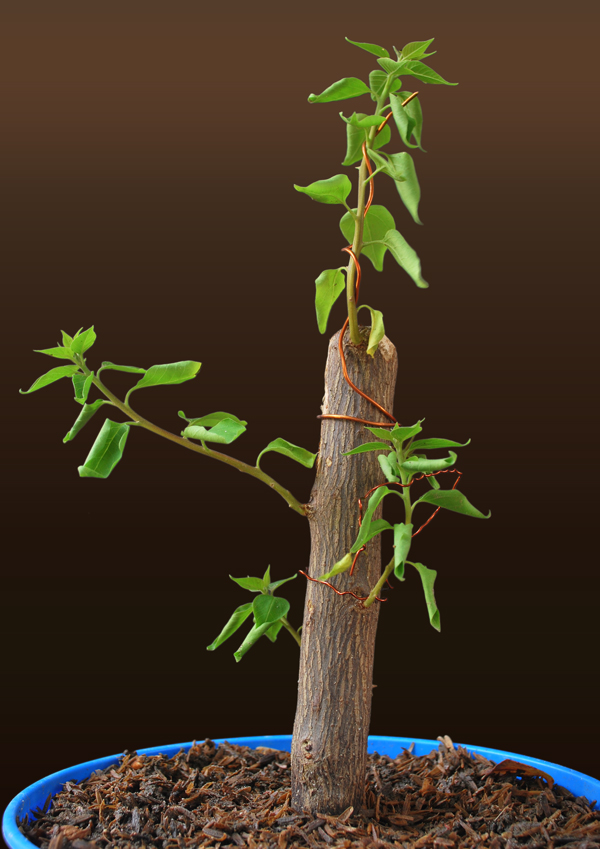Propagation of Bougainvillea
Some of you know that October is my birthday month. And, since we didn’t meet over the summer season, I decided to use this article to chat about what is currently of importance to me.
In the late 1960s, San Diego State had climbing bougainvillea cascading down a hill to the parking lot just off I-8. It was absolutely beautiful and became the inspiration for planting the rest of my plants at the beginning of the canyon slope, just beyond our house.
Many people dislike bougainvillea, particularly if they have a swimming pool. The bracts, the colored petals surrounding the tiny flowers, die and fall to the ground, leaving a profusion of fluffy but messy debris a few inches deep. I, however, love this about them. This debris is light, easy to rake, and is no strain to carry a trash bin full up two flights of stairs. It reminds me of raking the fallen autumn leaves in cold climates, but it is easier and still allows the fun of jumping and playing in them. (Yes, I still do that.)
When we purchased our current house, in 1971, I bought and planted several four-inch potted climbing bougainvillea plants. I believe I planted six or eight. In those days our canyon was more accessible, so I planted one a far distance down the slope. Periodically it still shows its blossoms, but the area is virtually impassable due to both erosion and lush growth. The rest of the plants we planted are a distance from the house so they could grow toward the canyon and away from the house. This was intentional, because, with time, bougainvillea can play havoc with stucco and other structures.
Twice these plants have grown into trees; they were cut to a one to-two-foot height in 1980 when we first remodeled our house. The bougainvillea loved the stucco debris that apparently fertilized their stumps. That’s because within a fairly short period of time, they reached tree height again. I love seeing their brilliant color from across the canyon. In the morning, from my bed, I can see their magenta hue reflected onto the white stucco of the exterior wall of the dining room.
Over the past fifty years, our home and the land surrounding it have undergone many transformations. The area that used to lead to a meadow, just past the street two flights below West Montecito Way, became overgrown with trees and other plants. Some of the trees died and were economically very difficult to remove. After many attempts to have them removed, I gave up. I decided to block the view of the dead trees with bougainvillea.
I needed several plants and the least expensive I found were $17.00 each. Then I had a brainstorm. I decided to propagate my own plants.
I started with little disposable pots, the kind you put in the ground. I trimmed many branches from our fifty-year-old trees and cut them into five-or-six-inch twigs. Then I mixed potting soil, sand, and dirt from my yard as bedding for my babies. I dabbed Root Tone on the bottom of each twig, stuck one or two in each pot, watered them, and placed each pot in a Zip-lock baggie. These I placed in the fireplace (which we haven’t used since we had the chimney cleaned fifteen years ago). I closed the screen to keep the cats out.
The moisture from the soil condensed on the baggies and kept the baby plants alive. After several weeks, I removed the baggies and set the plants outdoors in the shade. After a couple of weeks, I carefully repotted them into larger pots or into large plastic glasses in which I poked drainage holes. By this time, about half of them had leaves; half did not. Most of the leafless twigs were in a pot with a thriving baby plant, so I left them together to avoid disturbing any roots.
Three weeks ago, two of my babies had visible roots in the soil and more coming out of the bottoms of their pots. I paid someone to dig a trench and a deep hole which I filled with a mixture of the removed dirt, planting mix, and gravel. I planted my two babies and a bunch of euphorbia tirucalli (pencil cactus).
This morning I noticed two more twigs are nearly ready to be planted, and a few more have died. The twigs are all on our lower balcony which gets light but is covered. Unfortunately, the cats enjoy wandering amongst these plants, sometimes knocking them over, which has done very little for the plants’ health. I think I shall move these plastic containers of growing twigs onto the dirt of thriving tomatoes and flowers, which will prevent the cats from accessing them.
I am truly excited about the future of these bougainvillea plants, and hope they are not going to be victims. In a previous article, I did confess to being a serial killer of plants. Hopefully, that won’t happen this time.
Mission Hills Garden Club is having a pre-Halloween pumpkin planting garden party. It takes place from 3 p.m. to 5 p.m., Sunday, October 24 at Mission Hills Nursery, located at 1525 Fort Stockton Drive. Cost is $15 for members and $20 for non-members. The fee includes plants and planting materials required for this fun and creative fall project. Each participant will leave the event with a live fall planting to welcome trick-or-treaters to their door. Children must attend with their supervising adult. Refreshments will be served.

Category: Education, Events, Gardening, Life Style, Local News, Nonprofit







